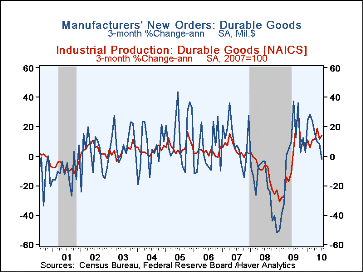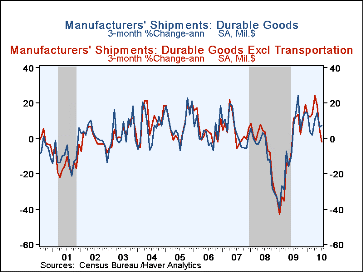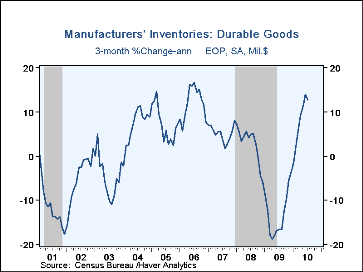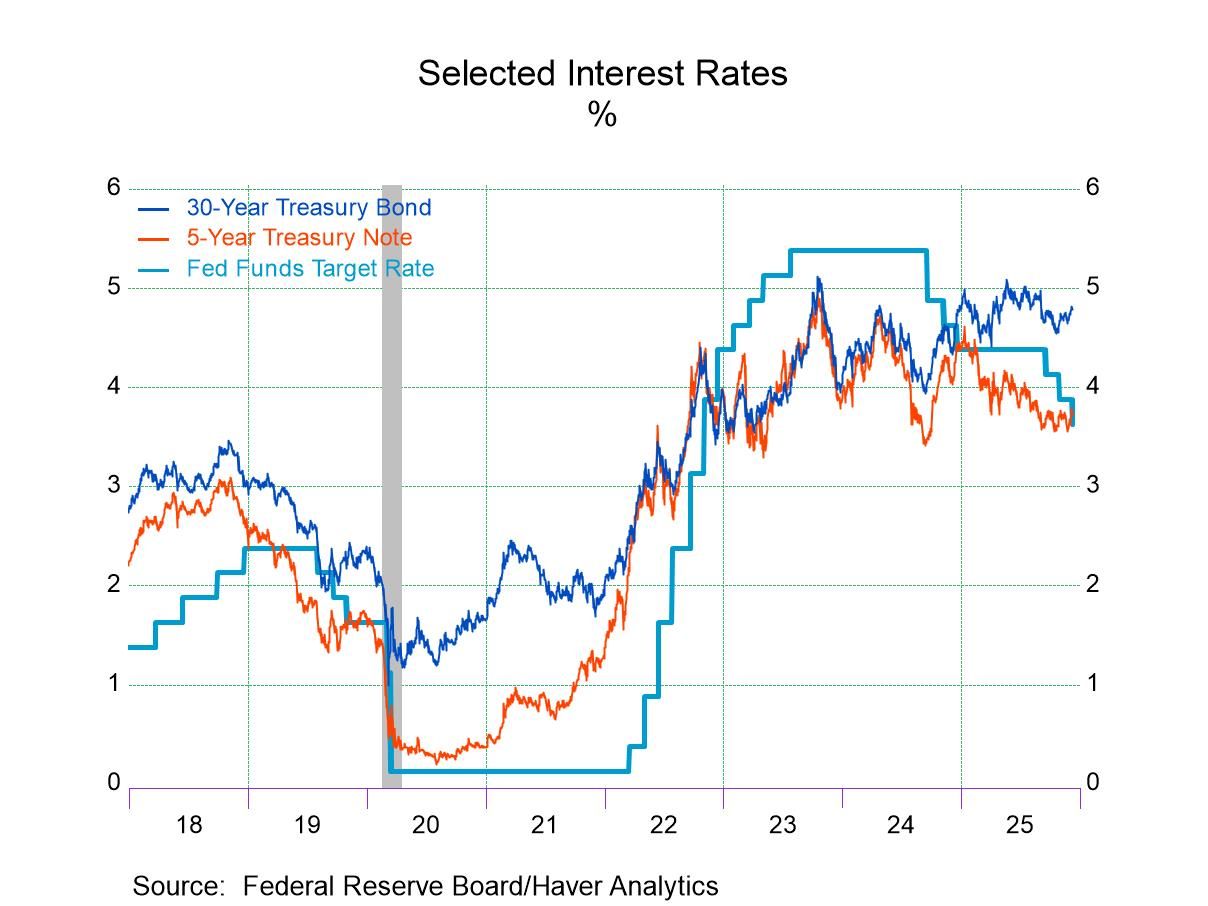 Global| Aug 25 2010
Global| Aug 25 2010U.S. Durable Goods Order Weakness Portends Easing Of Factory Sector Growth
by:Tom Moeller
|in:Economy in Brief
Summary
By itself, a 0.3% gain in July durable goods orders might be an encouraging sign from the Commerce Department for factory sector growth. But several aspects of the report paint a dimmer picture of the U.S. manufacturing sector. 1) The [...]
 By itself, a 0.3% gain in July durable goods orders might be an encouraging
sign from the Commerce Department for factory sector growth. But several aspects
of the report paint a dimmer picture of the U.S. manufacturing sector. 1) The
increase followed two months of slim gain which together left the three-month
change down 2.1% after double-digit growth this spring. 2) Excluding bookings in
the highly volatile transportation sector, orders fell by 3.8% and pulled
three-month growth to -8.7%. 3) Orders weakness has been widespread amongst
industry groups.
By itself, a 0.3% gain in July durable goods orders might be an encouraging
sign from the Commerce Department for factory sector growth. But several aspects
of the report paint a dimmer picture of the U.S. manufacturing sector. 1) The
increase followed two months of slim gain which together left the three-month
change down 2.1% after double-digit growth this spring. 2) Excluding bookings in
the highly volatile transportation sector, orders fell by 3.8% and pulled
three-month growth to -8.7%. 3) Orders weakness has been widespread amongst
industry groups.
Leading last month's orders' weakness was a 15.0% decline in the (+14.1% y/y) machinery sector and a large 12.7% drop (+7.8% y/y) in orders for computers & related products. Electrical equipment orders dropped 5.9% (+5.4% y/y), for the third decline in the last four months, and fabricated metals orders fell 1.0% (+8.2% y/y). Partially offsetting these declines were a 5.3% increase (19.9% y/y) in motor vehicles and a 3.9% gain (-17.3% y/y) in orders for communications equipment.
Earlier strength in nondefense capital goods orders also gave way to weakness with a 2.8% July decline. That lowered the three-month change to -8.0% after more-than tripling earlier this year versus 2009. Much of this weakening was due to lower bookings for commercial aircraft. Excluding aircraft, July orders still fell 8.0%, lowering three-month growth to -0.6% after surging this spring.
Orders weakness has begun to weaken shipments of durable goods. Though shipments rose 2.2% last month and at a firm 7.4% annual rate during the last three, they reflected growth in commercial aircraft (10.4% y/y and motor vehicles (18.7% y/y). For July, excluding the transportation sector altogether, shipments rose just 0.6% and dropped at a 2.0% rate during the last three months. Machinery shipments weakened (8.8% y/y) as did shipments of computers (4.1% y/y). To an extent this weakening was offset by continuing strength in nondefense capital goods (8.8% y/y).
A weakening of inventory accumulation was behind some of the easing in orders & shipments. Durable goods inventories rose 0.6% (2.2% y/y) after much stronger spring gains. That's, however, just a partial reversal of a 12.8% decline during all of last year. Inventories remained 9.8% below the late-2008 peak. Finally, backlogs of durable goods orders slipped 0.1% last month but remained down 2.0% y/y.
The durable goods figures are available in Haver's USECON database.
| NAICS Classification(%) | July | June | May | Y/Y | 2009 | 2008 | 2007 |
|---|---|---|---|---|---|---|---|
| Durable Goods Orders | 0.3 | -0.1 | -0.7 | 9.3 | -20.7 | -9.0 | 9.7 |
| Excluding Transportation | -3.8 | 0.2 | 1.4 | 9.5 | -18.4 | -2.5 | 4.5 |
| Nondefense Capital Goods | -2.8 | 1.2 | -0.4 | 8.6 | -26.8 | -12.6 | 17.5 |
| Excluding Aircraft | -8.0 | 3.6 | 4.7 | 10.6 | -19.8 | -4.2 | 5.3 |
Tom Moeller
AuthorMore in Author Profile »Prior to joining Haver Analytics in 2000, Mr. Moeller worked as the Economist at Chancellor Capital Management from 1985 to 1999. There, he developed comprehensive economic forecasts and interpreted economic data for equity and fixed income portfolio managers. Also at Chancellor, Mr. Moeller worked as an equity analyst and was responsible for researching and rating companies in the economically sensitive automobile and housing industries for investment in Chancellor’s equity portfolio. Prior to joining Chancellor, Mr. Moeller was an Economist at Citibank from 1979 to 1984. He also analyzed pricing behavior in the metals industry for the Council on Wage and Price Stability in Washington, D.C. In 1999, Mr. Moeller received the award for most accurate forecast from the Forecasters' Club of New York. From 1990 to 1992 he was President of the New York Association for Business Economists. Mr. Moeller earned an M.B.A. in Finance from Fordham University, where he graduated in 1987. He holds a Bachelor of Arts in Economics from George Washington University.








